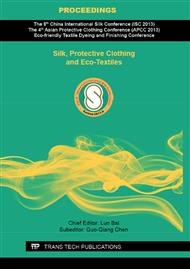p.43
p.48
p.57
p.62
p.67
p.72
p.79
p.83
p.87
Differential Expression of Stage-Specific Fat Body Proteins during Larval-Pupal Period in Silkworm (Bombyx mori)
Abstract:
The silkworm fat body is the organ of many intermediary metabolic processes and sustenance of growth throughout the life, and its proteins are responsible for storing nutrients, providing energy and regulating hormones. To date, detailed differential expressions of fat body proteins have not been clearly analyzed. In this research, fat body proteins were extracted from the larvae of the 5th day of the 5th instar, un-pupated larvae of spinning end and pupae of pupating day of the multivoltine silkworm variety Da Zao, and the differential expressed proteins were characterized by two-dimensional gel electrophoresis, followed by mass spectrometry identification and informatics method. 14 stage-specific expression proteins were detected and confirmed. Among them, 7 proteins were accurately identified, such as actin, calponin-like protein, beta-tubulin, hypothetical protein, antichymotrypsin precursor and 30K protein precursor etc. The biological roles of these important proteins during the larval-pupal developmental stages were discussed.
Info:
Periodical:
Pages:
67-71
Citation:
Online since:
September 2013
Authors:
Price:
Сopyright:
© 2013 Trans Tech Publications Ltd. All Rights Reserved
Share:
Citation:


